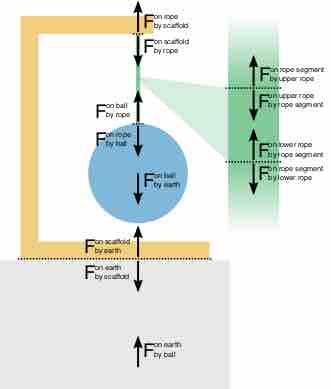The physics of connected objects is very similar to physics of simple objects. There are a variety of ways objects can be connected to each other, and a corresponding variety of mathematical ways to model such connections.
The simplest form of connection is a perfectly rigid connection. If two objects are connected by a perfectly rigid connector then they may be thought of as the same object. Perfectly rigid connectors cannot stretch nor deform, and transfer forces instantaneously from one side of the connection to the other. For example, given two blocks (both of mass 1 kg) connected by a perfectly rigid bar, if the first block is pulled with a force of 1 Newton, then both blocks will accelerate at the same time and the same acceleration. In this case the acceleration is
One can think of the force transferring through the connection by means of the "tension" force. Tension is the pulling force exerted by a string, chain, or similar connector on another object. If two objects are connected by a string, a force exerted on one is balanced by a tension force in the string which pulls on the other. Of course, if the tension force is greater than the rope can withstand, the rope will break.

Tension Forces
The forces involved in supporting a ball by a rope. Tension is the force of the rope on the scaffold, the force of the rope on the ball, and the balanced forces acting on and produced by segments of the rope.